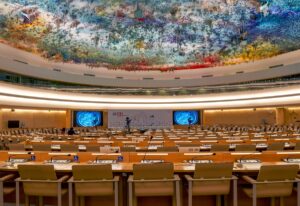Introduction
The historian John Lewis Gaddis wrote of military strategy that the “[e]nds and means have to connect if anything is to happen.” The same is true of the practice of diplomacy. In the present era, a gap exists between the ambitious strategies outlined by various U.S. administrations and the deployment of American diplomats to the areas and issues designated as high priorities in U.S. strategies.
The U.S. Department of State (DOS) lacks an authoritative and reliable point of reference for how it will execute the president’s national security goals. As a result, the American people and U.S. allies and partners do not have a clear understanding of how the DOS is using diplomacy to mitigate global threats. Despite multiple attempts over the years, each new administration has mostly discarded the works of its predecessors and started over. Congress has made a few half-hearted efforts through various authorizations, but it has not required compliance and has largely ignored this pressing issue.
To remedy this situation, Congress should consider mandating a Diplomatic Posture Review (DPR). Modeled after the U.S. Department of Defense’s (DOD’s) Global Defense Posture Report (GPR), and informed by past related efforts, a DPR would serve to align the State Department’s limited resources with the foreign policy imperatives of a given administration, while facilitating clearer communication to Congress and the American people about how the department is pursuing the goals outlined in the National Security Strategy (NSS).
Models & Lessons From Past Planning
Many within DOS recognize that a system to analyze diplomatic posture and direct the allocation of personnel would be worthwhile. In 2020, DOS conducted a strategic staffing initiative that examined what political, economic, and public diplomacy positions could be shifted to priority regions and areas. This was a useful model that began with the undersecretary for political affairs identifying where expertise should be focused and the undersecretary for management overseeing the staffing review. However, this was an ad hoc process that was dependent on the right leadership personalities providing direction for such an undertaking and was restricted in scope. Significant limits on the available data prevented decisionmakers in DOS from acquiring a baseline understanding of where staff were positioned and how they might be best utilized. A surfeit of positions resulting from the shrinkage of Embassy Baghdad and reductions and eventual closure of Embassy Kabul eased the pressure and enabled some shift in positions. In all, the 2020 review demonstrated a recognition of the need for a high-level examination of the department’s posture and provided lessons for how a more comprehensive effort might be conducted and an understanding of the remaining impediments.
Although the State Department’s mission and resources are much more limited than those of the DOD, the GPR is a useful model for conceptualizing how a congressionally mandated review might look. The law requires DOD to submit to Congress a yearly GPR that details any major changes to the defense posture of the United States that are necessary in order to execute DOD’s strategy and plans. In fulfilling this requirement, administrations have previously released a public summary GPR following the publication of the National Defense Strategy (NDS), which allows DOD to explain how personnel, equipment, and bases will be shifted to meet the priorities outlined in the strategy. Most important, the GPR is required to include a “description of the status of treaty, access, cost-sharing, and status-protection agreements with foreign nations;” the mandate pushes DOD to make Congress and the administration aware of potential issues with partner countries.
As with its military counterpart, a DPR would require each administration to periodically explain to the American people and other nations what means the DOS will employ and where it is working to advance U.S. national interests and would demonstrate the department’s agility to adapt to shifting global circumstances and new strategic goals. While the GPR has traditionally followed the publication of the NDS, a DPR would benefit from publication after the NSS, allowing it to communicate to Congress, the American public, and the administration how the State Department will use its limited resources to pursue U.S. strategic interests. Most important, the structuring of a DPR should be informed by criticisms of the most recent GPR: that it failed to make meaningful changes to U.S. defense posture, in part because it was released before the NDS. Even by the measures articulated in the interim NSS that preceded its release, the recent GPR made only minor procedural adjustments and fell far short of meeting the major changes to U.S. posture that the Biden administration ostensibly sought. The administration, for example, refused to close any bases in the Middle East so resources could be shifted to the Indo-Pacific.
The parallel with the Pentagon’s mandate to produce the GPR has limits: far fewer resources are dedicated to diplomacy than to military readiness, and diplomatic engagement has much more modest goals. This difference has been reflected in the halting and fundamentally dissimilar approach the State Department has taken to planning; much of that divergence is understandable and necessary, yet U.S. diplomatic infrastructure could clearly benefit from some visible forethought and better intentionality.
The State Department’s storied efforts to introduce proactive planning have had common goals but achieved limited lasting results. In any organization, effective planning is about much more than a particular process or specific plan. Rather, the process and outcome need to be embraced by the whole organization, especially leadership, and such planning needs to be fully and continuously integrated into the organization’s culture and work.
Currently, the State Department and U.S. Agency for International Development (USAID) have a four-part cycle that consists of planning, budgeting, managing, and learning. The culmination of the planning process is through a five-year Joint Strategic Plan (JSP), the latest of which, issued in March 2022, “supports the policy positions set forth by President Biden in the Interim National Security Strategic Guidance and presents how the State Department and USAID will implement U.S. foreign policy and development assistance.” Nested under the JSP are Joint Regional Strategies, Functional Bureau Strategies, Integrated Country Strategies, Performance Plans and Reports, and Evidence Act Reports that build out how the goals embodied in the NSS and the JSP will be achieved and feed into the budgetary and management planning processes. This planning framework is an outgrowth of four principal statutes: the Government Performance and Results Modernization Act of 2010, the Foreign Aid Transparency and Accountability Act of 2016, the Program Management Improvement Accountability Act of 2016, and the Foundations for Evidence-Based Policymaking Act of 2018 (Evidence Act). The JSP’s Overview promises that “the Department and USAID will use the JSP as a management tool to define success in international diplomacy and development … ” Yet, once the plan has been completed, it is unclear whether it is implemented or followed in any consistent and lasting manner.
The DPR would be an opportunity to take a step back to fully assess and communicate—to the American people and a global audience—how diplomatic assets would be employed to fulfill the president’s national security strategy.
The Quadrennial Diplomacy and Development Review (QDDR) was a more ad hoc approach launched by Secretary of State Hillary Clinton and carried forward by her successor, John Kerry. The goal of the QDDR was to map out U.S. diplomacy and development efforts and connect the State Department’s and USAID’s missions to existing capacities while identifying resource requirements. It was also designed to be the basis for institutional reform initiatives. Lacking a statutory basis, it only resulted in two reports, in 2010 and 2015, and was discontinued under the Trump administration.
An earlier, even fuzzier effort in the second Bush administration, championed by Secretary of State Condoleezza Rice, was “Transformational Diplomacy,” which was intended as a reckoning with the post-Cold War environment at the dawn of the 21st century. Part of its goal was to make U.S. diplomacy more muscular and “expeditionary” to match the increased militarization of foreign policy resulting from the wars in Afghanistan and Iraq. Another aim, though, was to redistribute diplomatic resources and capabilities away from regions deemed less critical to U.S. national interests, such as Europe, to other regions, such as the Middle East and Asia, where the United States faced a host of challenges and opportunities.
Why a Diplomatic Posture Review?
What would be the differentiated value of a DPR? The existing planning process, although comprehensive, is internally and programmatically directed. As a complement to that, the DPR would be an opportunity to take a step back to fully assess and communicate—to the American people and a global audience—how a full range of diplomatic assets would be employed to fulfill the president’s national security strategy. To do this effectively, it should start from a zero-based perspective, asking what is actually needed now and in the future, rather than just looking at the resources the department already has that might be updated or tweaked. In addition, the review could be premised on the need for diplomatic agility and adaptability to shifting global perils and circumstances. How should the United States position its limited diplomatic resources, attention, and actions to best advance its national interests? Moreover, rather than applying an exclusively geographic lens on regions and key countries, the DPR could also use a functional or thematic lens to consider whether the United States’ diplomatic posture is really fit to tackle emerging and disruptive threats in, for example, the cyber and outer space domains.
The actual or expected role of other nations should also be taken into consideration. Given that the United States often exercises its power through its alliances and partnerships, the DPR needs to factor in, both explicitly and implicitly, the views of U.S. friends, as well as their goals, and anticipate adversaries’ actions. As the powerful and effective international response to Russia’s war on Ukraine has amply demonstrated, U.S. leadership requires coalition-building and tending. U.S. diplomacy needs to demonstrate how its posture would contribute to maintaining and extending those international partnerships. The DPR would be a chance to set out some core principles that guide U.S. foreign policymaking and practice. Through a clearer and more forceful exposition of U.S. diplomatic aims, the international community would have a better understanding of the U.S. direction of travel and Washington’s plans to get there.
A DPR would also provide the opportunity for the State Department to make purposeful shifts in the allocation of its resources to various regions and issues. While many positions are not fungible and meaningful movements can take time, the DPR could be used by DOS leadership to identify personnel well suited to be shifted to bureaus and consulates that are important to addressing diplomatic imperatives. For example, a DPR could allow DOS to better execute an administration’s strategy for alliance-building in East Asia, explaining how it will shift resources to open new consulates in the region and where staff will be drawn from to make such a push. Because the DPR would not be a budgetary document, it should reflect not just the areas where DOS plans to enhance its efforts, but also the areas from which it plans to shift resources. This means including details on how to move staff quickly and effectively across issue areas and regions, with explanations of how the department will train and retain staff to meet these goals.
Implementation
Implementing a new strategy document will need to draw upon already limited staff time. For a DPR to be worthwhile, the document would need to increase the State Department’s ability to meet the foreign policy priorities of a given administration, aligning ways and means, and communicating key objectives to policymakers and the public. Although the authors of this brief believe that a DPR could be instrumental in achieving these goals and helping to elevate the role of diplomacy as a tool to achieve U.S. foreign policy objectives, the process for constructing a DPR, and securing a commitment to implementing its findings, would ultimately determine whether or not it was successful. Writing of the most recent GPR, former Bush 43 and Reagan administration official Dov Zakheim lamented that the document “hardly seems to have been worth the personnel, time, effort and taxpayer money that went into what ultimately can only be termed a highly disappointing product.” Such an outcome should be avoided by purposefully creating a structure for the DPR that ensures its recommendations will be substantive and in line with the foreign policy priorities of a given administration and that there will be pressure from both the White House and Congress to implement its findings.
Congress would play a significant role in determining whether a DPR would be successful, both in how it structured the mandate for a DPR and its willingness to hold to account those tasked with implementing it. A requirement to produce the DPR, and have it follow publication of the congressionally mandated NSS, would ensure the DPR did not meet a fate similar to that of the orphaned QDDR. Including language to require a DPR in a State Department authorization bill would further efforts undertaken by previous sessions of Congress to modernize the department. But even if an authorization specifically for State proves infeasible, including a requirement in the National Defense Authorization Act (NDAA) would be a continuation of the effort made in the 2023 NDAA to update the DOS workforce and its issue areas, which were expanded with the creation of the Bureau of Cyberspace and Digital Policy. Mandating a DPR would help ensure that efforts to adapt U.S. diplomacy to the ever-changing circumstances of international affairs is iterative, rather than haltingly ad hoc as has been the case for too long.
If implemented, a DPR could prove to be a useful tool for both optimizing the operations of the State Department and promoting its capabilities to advance U.S. foreign policy interests through diplomacy. A public version of a DPR would inform the American public where U.S. government efforts are being focused to improve relations, build more lucrative ties, and understand the threats of adversaries. Although creating a new strategy document will require a substantial effort by both Congress, to initiate the process, and the State Department, to implement it, the payoff of creating a thoughtful system of reviewing the United States’ diplomatic posture would ultimately serve to improve the tool of U.S. diplomacy.




